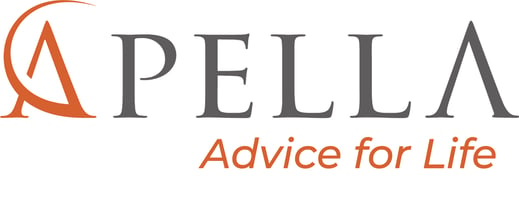Apella Wealth Blog

CRAT, CRUT, WHAT? The Alphabet Soup of Philanthropy
For those that are charitably inclined, there are myriad options at your disposal. These options include Donor Advised Funds (DAF), Qualified Charitable Distributions (QCD), Charitable Remainder Annuity Trust (CRAT), Charitable Remainder Unitrust (CRUT) and the list goes on. One could get dizzy trying to learn the acronyms, let alone understanding the tax impact each may have on your situation. This article will explore two of these options: the CRAT and the CRUT.
CRAT’s and CRUT’s are each a type of Charitable Remainder Trust (CRT). A Charitable Remainder Annuity Trust (CRAT) is an irrevocable trust where the beneficiaries of the trust are “split” between a non-charitable beneficiary and a charitable organization. The non-charitable beneficiary receives a steady income stream from the trust and the charitable organization receives the remainder of the assets in the trust at the end of the payment period. A CRAT is established by a grantor, who funds the trust with a partially tax-deductible donation. The Grantor then decides on the length of the payment period as well as the dollar amount paid each year to the income beneficiary. The payment period can be for a certain period (up to 20 years) or for the lifetime of one or more of the beneficiaries. The payment amount will be the same each year regardless of how the assets perform and must payout between five and 50 percent of the original trust value. As an irrevocable trust, there are few to no changes that can be made, including the inability to place additional assets to the trust.
A Charitable Remainder Unitrust (CRUT) is similar in structure to a CRAT, as an irrevocable trust that splits beneficiaries between charitable and non-charitable beneficiaries. The non-charitable beneficiaries still receive an income stream, but it is based on a percentage of the trust's current value, as opposed to a certain dollar amount. This means the trust must be valued each year and the income can vary from year to year. Unlike the CRAT, you can add additional assets to this trust over time, providing some flexibility when balancing philanthropy and tax mitigation.
These trusts provide the flexibility of giving your assets to charity, while still generating an income stream for yourself or other beneficiaries. CRUTs are designed primarily to help with tax mitigation with additional estate and retirement planning advantages. The grantor will get a partial tax-deduction for the original donation to the trust and the growth of the assets inside the trust is not taxable. However, the distributions to income beneficiaries are subject to special tax rules and may be taxable to the recipient. It can also be funded by appreciated assets (up to 30% AGI) which allows the donor to avoid capital gains tax.
Both types of Charitable Remainder Trusts have gained recognition recently due to their inclusion in the Legacy IRA Act passed in 2022. Since 2023 IRA owners who are over 70.5 can use a Qualified Charitable Deduction (QCD) to fund up to $53,000 into a CRAT or CRUT. This donation would count towards the owners required minimum distribution (RMD), and because it is a QCD, there would not be income tax on the distribution from the IRA. This would be of particular interest to the owners of large IRAs that are charitably inclined and want to establish an income stream for themselves or other family members.
You could consider a CRT if you wanted to support a loved one during their lifetime but ultimately wanted to leave the assets to a charitable organization. Another potential use would be to move assets out of your estate prior to your death while still providing yourself an income stream from those same assets. That said, they are not for everyone and come with legal fees to establish and incur ongoing maintenance fees. Additionally, you should consult with your tax and financial professionals to ensure proper set up and compliance with tax law. As always, Apella is here to help you make the best choices for your specific situation by leading with financial planning and getting to truly understand your needs.
Sources:
Charitable remainder trusts | Internal Revenue Service
Disclosures:
Apella Capital, LLC (“Apella”), DBA Apella Wealth is an investment advisory firm registered with the Securities and Exchange Commission. The firm only transacts business in states where it is properly registered or excluded or exempt from registration requirements. Registration with the SEC or any state securities authority does not imply a certain level of skill or training. Different types of investments involve varying degrees of risk, and there can be no assurance that the future performance of any specific investment, investment strategy, product or any non-investment-related content made reference to directly or indirectly in this material will be profitable, equal any corresponding indicated historical performance level(s), be suitable for your portfolio or individual situation, or prove successful. Due to various factors, including changing market conditions and/or applicable laws, the content may not be reflective of current opinions or positions. Please note the material is provided for educational and background use only. Diversification seeks to improve performance by spreading your investment dollars into various asset classes to add balance to your portfolio. Using this methodology, however, does not guarantee a profit or protection from loss in a declining market. Past performance does not guarantee future results. All data is from sources believed to be reliable but cannot be guaranteed or warranted.
No current or future client should assume that any discussion or information contained in this material serves as the receipt of, or as a substitute for, personalized investment advice. As with any investment strategy, there is the possibility of profitability as well as loss.
Apella Wealth does not provide insurance services or legal advice and nothing either stated or implied here should be inferred as providing such advice.
Related Articles
GameStop and Other Recent Market Craziness
If there’s one thing you can say about working in financial services, it’s that there’s never a...From Building Wealth to Creating Meaning: Charitable Giving at Life’s Milestones
Reaching a milestone birthday or entering retirement is about more than celebrating the years...
